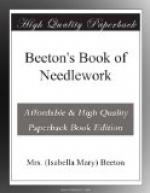[Illustration: 68.—Overcast Stitch.]
ILLUSTRATION 68 (Overcast Stitch).—The double overcast and the button-hole stitches are worked from left to right, whilst back stitches, knotted and satin stitches are worked from right to left. The stitch is worked in the same way as the double overcast, only the needle must never be drawn out above, but below, the cotton with which you work, and which you keep down with the thumb of the left hand.
[Illustration: 69.—Slanting Overcast Stitch.]
ILLUSTRATION 69.—The slanting overcast stitch is worked without tracing the outline, always inserting the needle downwards—that is, from top to bottom. The needle must be inserted in the manner shown in illustration—that is, not straight, but slanting; insert it a little farther than the last stitch, and draw it out close to it. The wrong side of the work must show back stitches. This sort of stitch is used for the fine outlines in patterns or letter.
[Illustration: 70.—Back Stitch.]
ILLUSTRATION 70.—This shows the back stitch, the working of which is well known; it is worked in several rows close to each other.
[Illustration: 71.—Point Croise.]
[Illustration: 72.—Point Croise.]
ILLUSTRATIONS 71 & 72 show another kind of back stitch, called point croise, which is only used on very thin and transparent materials. This stitch forms on the wrong side a sort of darned pattern, which is seen by transparence on the right side, and gives the embroidered pattern a thicker appearance, contrasting with the rest of the work (see the lower leaves of the flower on illustration 110). For this stitch insert the needle into the material as for the common back stitch, draw it out underneath the needle on the opposite outline of the pattern, so as to form on the wrong side a slanting line. Insert the needle again as for common back stitch; draw it out slanting at the place marked for the next stitch on the opposite outline, as shown in illustration 71.
[Illustration: 73—– Knotted Stitch.]
ILLUSTRATION 73 shows the knotted stitch; the simplest way of working it is to work two back stitches at a short distance from each other over the same thread.
The knotted stitch seen in ILLUSTRATION 74 is worked thus:—Take about four threads of the material on the needle, draw the needle half out, wind the cotton twice round the point of the needle, hold it tight with the thumb, draw the needle out carefully and insert it at the place where the stitch was begun, and draw it out at the place where the next stitch is to be worked.
[Illustration: 74.—Knotted Stitch.]
[Illustration: 75.—Knotted Stitch]
The knotted stitch seen on ILLUSTRATION 75 is worked in nearly the same manner as the preceding one. Before drawing the cotton out of the material hold it tight with the left-hand thumb; leave the needle in the same position, wind the cotton twice round it, turn the needle from left to right, so (follow the direction of the arrow) that its point arrives where the cotton was drawn out (marked by a cross in illustration), insert the needle there, and draw it out at the place of the next stitch.




